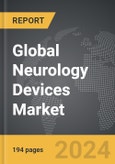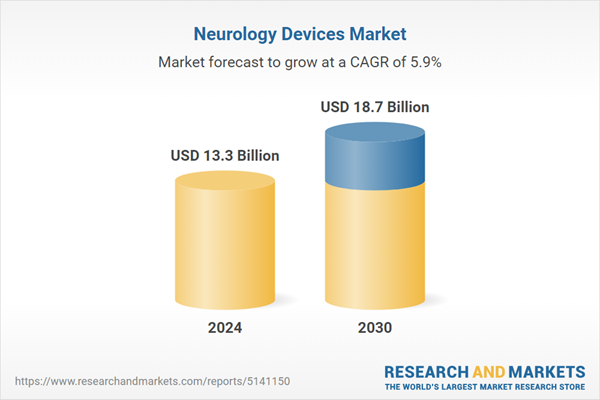The global market for Neurology Devices was valued at US$13.3 Billion in 2024 and is projected to reach US$18.7 Billion by 2030, growing at a CAGR of 5.9% from 2024 to 2030. This comprehensive report provides an in-depth analysis of market trends, drivers, and forecasts, helping you make informed business decisions. The report includes the most recent global tariff developments and how they impact the Neurology Devices market.
Segments: Device Type (Cerebrospinal Fluid Management, Neurostimulation, Interventional Neurology, Neurosurgery, Other Device Types); End-Use (Hospitals, Ambulatory Surgery Centers, Other End-Uses).
Geographic Regions/Countries: World; United States; Canada; Japan; China; Europe (France; Germany; Italy; United Kingdom; Spain; Russia; and Rest of Europe); Asia-Pacific (Australia; India; South Korea; and Rest of Asia-Pacific); Latin America (Argentina; Brazil; Mexico; and Rest of Latin America); Middle East (Iran; Israel; Saudi Arabia; United Arab Emirates; and Rest of Middle East); and Africa.
The analysts continuously track trade developments worldwide, drawing insights from leading global economists and over 200 industry and policy institutions, including think tanks, trade organizations, and national economic advisory bodies. This intelligence is integrated into forecasting models to provide timely, data-driven analysis of emerging risks and opportunities.
Global Neurology Devices Market - Key Trends & Drivers Summarized
How Are Neurology Devices Advancing the Treatment of Neurological Disorders?
Neurology devices have become integral in diagnosing, monitoring, and treating a wide range of neurological disorders, from epilepsy and Parkinson's disease to stroke and traumatic brain injury. These devices encompass a broad range of technologies, including neurostimulation devices, neurodiagnostic systems, and cerebrospinal fluid management equipment. With neurological disorders on the rise due to aging populations and increasing awareness of mental health conditions, the demand for these devices has grown exponentially. Innovations such as deep brain stimulation (DBS) for treating movement disorders, as well as advanced imaging technologies like electroencephalograms (EEGs), are enabling more precise and less invasive diagnosis and treatment options, significantly improving patient outcomes.What Role Does Technology Play in Shaping Neurology Device Innovations?
The advancement of neurology devices is closely tied to technological innovations in fields like robotics, artificial intelligence (AI), and miniaturization. AI-powered diagnostic tools are enhancing the ability to detect neurological disorders early, while robotic-assisted surgery is increasing the precision and safety of neurosurgical procedures. Additionally, wearable neurostimulation devices, which deliver low-frequency electrical pulses to treat conditions like migraines or depression, are providing non-invasive alternatives to medication. Miniaturization has enabled the development of smaller, implantable devices, making treatments like DBS more comfortable and accessible for patients. These advancements are not only expanding the capabilities of neurology devices but also improving the quality of life for individuals with neurological conditions.How Are Demographic and Healthcare Trends Impacting the Neurology Devices Market?
The growing prevalence of neurological disorders, particularly among aging populations, is a key factor driving demand for neurology devices. Conditions such as Alzheimer’s disease, stroke, and Parkinson’s are becoming more common, requiring advanced devices for both diagnosis and long-term management. In addition, increased healthcare spending and a rising focus on improving the quality of neurological care are spurring investments in new technologies and therapies. Emerging markets are also seeing a surge in demand for neurology devices as healthcare infrastructure improves, and awareness of neurological disorders rises. Meanwhile, regulatory bodies are streamlining approval processes for neurology devices that demonstrate significant therapeutic benefits, further driving market growth.The Growth in the Neurology Devices Market Is Driven by Several Factors
The growth in the neurology devices market is driven by several factors, including the rising incidence of neurological disorders, particularly in aging populations, which is creating greater demand for advanced diagnostic and therapeutic devices. Technological advancements, such as AI-driven diagnostics, robotic-assisted surgeries, and wearable neurostimulation devices, are enhancing the precision and effectiveness of these treatments. Additionally, increasing healthcare expenditure, particularly in emerging markets, is making these advanced devices more accessible. Moreover, the trend toward non-invasive treatment options and improved patient outcomes is prompting healthcare providers to adopt newer, more sophisticated neurology devices. The expanding regulatory support for innovative neurology devices is further fueling the market, as faster approvals are encouraging the adoption of cutting-edge technologies.Report Scope
The report analyzes the Neurology Devices market, presented in terms of units. The analysis covers the key segments and geographic regions outlined below.Segments: Device Type (Cerebrospinal Fluid Management, Neurostimulation, Interventional Neurology, Neurosurgery, Other Device Types); End-Use (Hospitals, Ambulatory Surgery Centers, Other End-Uses).
Geographic Regions/Countries: World; United States; Canada; Japan; China; Europe (France; Germany; Italy; United Kingdom; Spain; Russia; and Rest of Europe); Asia-Pacific (Australia; India; South Korea; and Rest of Asia-Pacific); Latin America (Argentina; Brazil; Mexico; and Rest of Latin America); Middle East (Iran; Israel; Saudi Arabia; United Arab Emirates; and Rest of Middle East); and Africa.
Key Insights:
- Market Growth: Understand the significant growth trajectory of the Cerebrospinal Fluid Management segment, which is expected to reach US$7.1 Billion by 2030 with a CAGR of a 5.8%. The Neurostimulation segment is also set to grow at 6.8% CAGR over the analysis period.
- Regional Analysis: Gain insights into the U.S. market, valued at $3.5 Billion in 2024, and China, forecasted to grow at an impressive 9.9% CAGR to reach $4.4 Billion by 2030. Discover growth trends in other key regions, including Japan, Canada, Germany, and the Asia-Pacific.
Why You Should Buy This Report:
- Detailed Market Analysis: Access a thorough analysis of the Global Neurology Devices Market, covering all major geographic regions and market segments.
- Competitive Insights: Get an overview of the competitive landscape, including the market presence of major players across different geographies.
- Future Trends and Drivers: Understand the key trends and drivers shaping the future of the Global Neurology Devices Market.
- Actionable Insights: Benefit from actionable insights that can help you identify new revenue opportunities and make strategic business decisions.
Key Questions Answered:
- How is the Global Neurology Devices Market expected to evolve by 2030?
- What are the main drivers and restraints affecting the market?
- Which market segments will grow the most over the forecast period?
- How will market shares for different regions and segments change by 2030?
- Who are the leading players in the market, and what are their prospects?
Report Features:
- Comprehensive Market Data: Independent analysis of annual sales and market forecasts in US$ Million from 2024 to 2030.
- In-Depth Regional Analysis: Detailed insights into key markets, including the U.S., China, Japan, Canada, Europe, Asia-Pacific, Latin America, Middle East, and Africa.
- Company Profiles: Coverage of players such as Abbott Laboratories, Inc., B. Braun Melsungen AG, Boston Scientific Corporation, Johnson & Johnson, Medtronic, Inc. and more.
- Complimentary Updates: Receive free report updates for one year to keep you informed of the latest market developments.
Some of the 42 companies featured in this Neurology Devices market report include:
- Abbott Laboratories, Inc.
- B. Braun Melsungen AG
- Boston Scientific Corporation
- Johnson & Johnson
- Medtronic, Inc.
- MicroPort Scientific Corporation
- Nihon Kohden Corporation
- Penumbra, Inc.
- Smith & Nephew PLC
- Stryker Corporation
Tariff Impact Analysis: Key Insights for 2025
Global tariff negotiations across 180+ countries are reshaping supply chains, costs, and competitiveness. This report reflects the latest developments as of April 2025 and incorporates forward-looking insights into the market outlook.The analysts continuously track trade developments worldwide, drawing insights from leading global economists and over 200 industry and policy institutions, including think tanks, trade organizations, and national economic advisory bodies. This intelligence is integrated into forecasting models to provide timely, data-driven analysis of emerging risks and opportunities.
What’s Included in This Edition:
- Tariff-adjusted market forecasts by region and segment
- Analysis of cost and supply chain implications by sourcing and trade exposure
- Strategic insights into geographic shifts
Buyers receive a free July 2025 update with:
- Finalized tariff impacts and new trade agreement effects
- Updated projections reflecting global sourcing and cost shifts
- Expanded country-specific coverage across the industry
Table of Contents
I. METHODOLOGYII. EXECUTIVE SUMMARY2. FOCUS ON SELECT PLAYERSIII. MARKET ANALYSISCANADAITALYSPAINRUSSIAREST OF EUROPESOUTH KOREAREST OF ASIA-PACIFICARGENTINABRAZILMEXICOREST OF LATIN AMERICAIRANISRAELSAUDI ARABIAUNITED ARAB EMIRATESREST OF MIDDLE EASTIV. COMPETITION
1. MARKET OVERVIEW
3. MARKET TRENDS & DRIVERS
4. GLOBAL MARKET PERSPECTIVE
UNITED STATES
JAPAN
CHINA
EUROPE
FRANCE
GERMANY
UNITED KINGDOM
ASIA-PACIFIC
AUSTRALIA
INDIA
LATIN AMERICA
MIDDLE EAST
AFRICA
Companies Mentioned (Partial List)
A selection of companies mentioned in this report includes, but is not limited to:
- Abbott Laboratories, Inc.
- B. Braun Melsungen AG
- Boston Scientific Corporation
- Johnson & Johnson
- Medtronic, Inc.
- MicroPort Scientific Corporation
- Nihon Kohden Corporation
- Penumbra, Inc.
- Smith & Nephew PLC
- Stryker Corporation
Table Information
| Report Attribute | Details |
|---|---|
| No. of Pages | 194 |
| Published | April 2025 |
| Forecast Period | 2024 - 2030 |
| Estimated Market Value ( USD | $ 13.3 Billion |
| Forecasted Market Value ( USD | $ 18.7 Billion |
| Compound Annual Growth Rate | 5.9% |
| Regions Covered | Global |









